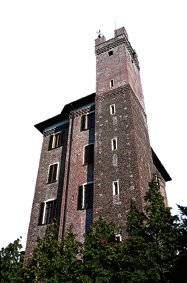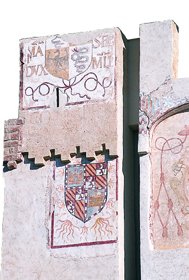- Abitanti:
Inhabitants number :2076
Superficie:
Surfacekmq: 17,84
Altitudine:
Altitude:123 m
Denominazione abitanti:
Inhabitants:vespolini
Cascine:
Farms:Barzè,
Bertottina,
Canè,
Casone,
Colombera,
Fornace,
Goretta,
Molino Coste,
Mondurla,
Mondurletta,
Torchietto
Patrono:
Patron: S. Giovanni (24/06)
Mercato:
Market:martedì /tuesday
Telefono:
Phone:0321
(Town Hall 0321 88 21 31)
Cap:
Postal code: 28079
Sito web: www.comune.
vespolate.no.it
e-mail: municipio@comune.
vespolate.no.it
Vespolate è un paese tradizionalmente agricolo e la nuova denominazione "Vespolate, paese sulla strada delle risaie" vuole appunto sottolineare questa vocazione del territorio. Sede, nel X secolo, di una "curtis" sottoposta al conte Uberto di Pombia e a Ugo Guala, vassallo episcopale, il borgo venne successivamente confiscato e assegnato all'Episcopato Novarese. Per quanto contrastata e a tratti solo formale, la supremazia vescovile durò fino al XIV secolo, quando, al termine delle lotte con il marchese del Monferrato, Galeazzo II Visconti assunse la giurisdizione sul luogo; da questo momento, non senza contrasti, il feudo venne assegnato di volta in volta a famiglie diverse.
“Vespolate, country on the path of rice” is an important agricultural center. The village , in the X century, was assigned to the episcopate Novarese until the XIV. After the struggles with the Marquis of Monferrato, Galeazzo II Visconti took the power. From this moment, Vespolate was assigned to different families.
Chiesa parrocchialeLa chiesa parrocchiale dedicata ai Santi Giovanni Battista e Antonio Abate sorge nel centro storico e si affaccia sulla piazza principale. Costruita sui resti di un antico oratorio nel Cinquecento, ha subito restauri nel 1772 e la modifica della facciata nel 1827 su progetto dell'architetto Orelli. All'interno sono da segnalare l'affresco raffigurante Santa Liberata, risalente al XVI secolo, e il dipinto a olio, di grandi dimensioni, raffigurante la Vergine con Bambino fra San Giovanni e Sant'Antonio, opera di Gabriele Bossi, datato 1572 e ora collocato sopra i settecenteschi corali. Di pregio sono gli altari marmorei collocati nel presbiterio, l'altare maggiore e l'altare del Santissimo Crocifisso.
Parish churchThe parish church dedicated to St John the Baptist and St Anthony Abbot stands on the main square. Built in the 16th century on the remains of an ancient oratory, the church was restored in 1772; the façade was altered in 1827 to designs by the architect Orelli. On the interior are some notable works: the fresco depicting St Liberata, from the 16th century, and the large oil painting by Gabriele Bossi, depicting the Virgin with Child between St John and St Anthony decorating the 18th century choir. Also remarkable are the marble altars in the presbytery, the main altar and the altar of the Holy Crucifix.
|
|
|
La Chiesa parrocchiale dei Santi Giovanni Battista e Antonio Abate / Parish church |
La Pieve di S. Giovanni
Battista / |
Santuario della Madonna della CrocettaNei pressi del cimitero sorge il santuario dedicato alla Madonna della Crocetta, edificato nel Novecento sui resti di un'antica cappella. Secondo la tradizione popolare, si narra che, nel Seicento, un generale spagnolo, accecato in battaglia, si fermò in preghiera davanti all'antica cappelletta e immediatamente riacquistò la vista. Come ringraziamento devozionale fu eretta, nel 1650, una chiesa a navata unica con presbiterio e altare marmoreo, ove fu collocata l'immagine sacra e tanto venerata della Vergine con Bambino, risalente al XV secolo e recuperata dall'antica cappella. Ora l'edificio si presenta a croce greca, notevolmente alterato nella sua forma originaria.
Madonna Crocetta sanctuaryThe sanctuary dedicated to the Madonna della Crocetta, erected in the 20th century on the remains of an ancient chapel stands near the cemetery. Legend says that in the 17th century, a Spanish general who had lost his sight ina battle stopped to pray at the ancient chapel and immediately recovered his sight. In 1650 a devotional church was erected on the site. It had a single nave and a presbytery featuring a marble altar; the altarpiece was the sacred 15th century image of the Virgin with Child preserved from the ancient chapel. The present church, built to a Greek-cross plan, is considerably different from the original structure.
|
Il Santuario della Madonna della Crocetta / Madonna della crocetta sanctuary |
St Giovanni Battista PieveThe pieve dedicated to St John the Baptist stand in open country, along the road leading to Tornaco. Documented in 1024-1028, when it was bequeathed by the bishop Peter III to the monastery of St Lawrence in Novara, the church is mentioned again in a document from 1132 reassigning it to the Church of Novara. The building has a single nave and a semicircular apse; the 17th century bell tower stands to the south side, where also a small chapel stands; a room with the function of sacristy is attached to the north wall. The ancient pieve had a nave and three aisles, but during substantial 18th century renovations the two aisles were demolished, considerably altering the balance of the interior. The church was lavishly frescoed in the 15th century. Outstanding is the altarpiece, representing the Virgin with Child flanked by St John the Evangelist, St John the Baptist, St Gaudenzio e St Francis; kneeling before the Virgin, is portrayed the donor, probably a member of the Cavallazzi family, feudal lords of the area. Over the altarpiece note a beautiful Annunciation flanked some coats or arms, including the Cavallazzi’s. Near the ossuary is a lovely Madonna feeding the Child, and on the left wall is a fresco with the Enthroned Virgin with Christ Child and Saints; another fresco depicting St Andrew flanks the entrance to the sacristy.
|
|
|
||
Santuario della Madonna della Crocetta: interno / Madonna della Crocetta sanctuary |
Il Castello di Vespolate / Vespolate castle |
|
Il CastelloNotizie dell'esistenza di un castello, in Vespolate, si hanno già
a partire dal 1053, quando Adelasia, vedova del Conte Alberto, cede
a Rodolfo da Besate, rappresentante di una nobile famiglia milanese,
buona parte degli immobili della zona, fra i quali anche il fortilizio.
Dell'antica struttura ora si conserva ben poco, perchè nel
corso dei secoli subì numerosi cambiamenti strutturali: in
particolar modo fra il Trecento e il Quattrocento, quando l'antico
"castrum" medievale (centro giuridico del territorio) perse
le sue funzioni fino a diventare un centro di raccolta di scorte alimentari.
Diversi furono i signori che si alternarono alla guida del borgo,
finché esso venne diviso: la rocca diventò un bene dei
vescovi novaresi, mentre il feudo passò definitivamente al
potere civile. I vescovi, fra i quali il Bascapè, Giovanni
Battista Visconti e Marco Aurelio Balbis Bertone, fecero ristrutturare
il castello e innalzare la torretta. Nel 1767 il bene passò
definitivamente alla Chiesa ma nel 1868, in seguito alla confisca
dei beni ecclesiastici, l'immobile venne ceduto al conte Borgogna.
Si succedettero quindi vari proprietari e ancora oggi il castello
è residenza privata. Ampiamente restaurato, si presenta a pianta
quadrata di fattura piuttosto rozza e priva di ornamenti; collegato
all'edificio è un alto torrione arricchito da due serie di
archetti pensili, da finestrelle e feritoie.
The castleThe castle of Vespolate is documented as far back as 1053, when Adelasia, Count Albert’s widow, sold a number of buildings, including the fortress, to Rodolfo from Besate, member of a noble family from Milan. Scarce remains survive from the ancient structure, as it was repeatedly altered over the centuries. The most substantial alterations date from the 14th and 15th centuries, after the ancient medieval “castrum” (the juridical center of the territory) lost its defensive function and was converted into a storehouse and granary. After being ruled by several feudal lords, the village was parted: the fortress was assigned to the bishops of Novara, and the feud passed to the secular power. The bishops, including Bascapè, Giovanni Battista Visconti and Marco Aurelio Balbis Bertone, had the castle restored and the turret erected. In 1767 the building was assigned to the Church again; but in 1868, after the expropriation of the clergy, the castle was acquired by the count Borgogna. Several owners followed, and the castle is till privately owned. Completely reconstructed, it is today a square featureless building adjoined by a tall tower adorned by two series of blind arches, arched windows and loopholes.


